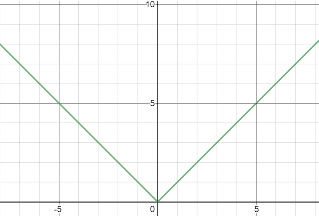
The absolute value of a real number, also referred to as its modulus, is the non-negative value of x without any regard for the sign of x; the absolute value of a number is always either positive or 0. One way to think of the absolute value of a number is as its distance from 0. The absolute value is denoted as |x| or abs(x), and functions such that:
For example, the numbers 2 and -2 have a distance of 2 from 0, so their absolute value is the same, even though their sign is not:
The absolute value of 0 is 0. The absolute value function, f(x) = |x|, can be described as a piecewise function:
Its graph, for real numbers, is an even function that has a sharp turn at the bottom, as shown in the figure below:

The absolute value function is also defined for complex numbers as well as other mathematical objects, but in the context of algebra, we will only discuss the absolute value function for real numbers. For real numbers, given that a and b are real numbers, the absolute value has the following properties:
This property just means that the absolute value of any real number is positive or 0.
This property is read as "the absolute value of a equals 0 if and only if a equals 0," meaning there is no real value that has an absolute value of 0 except for 0 itself.
The property of multiplicativity states that the absolute value of the product of a and b is the same as the absolute value of the products of the absolute value of a and b individually. This can be useful when manipulating or solving equations that involve absolute values.
The property of subadditivity states that the absolute value of the sum of a and b will always be less than or equal to the sum of each of their absolute values. This, like the property of multiplicativity, is a useful property when manipulating or solving equations involving absolute values.